Fitzgerald A.E. Electric Machinery
Подождите немного. Документ загружается.

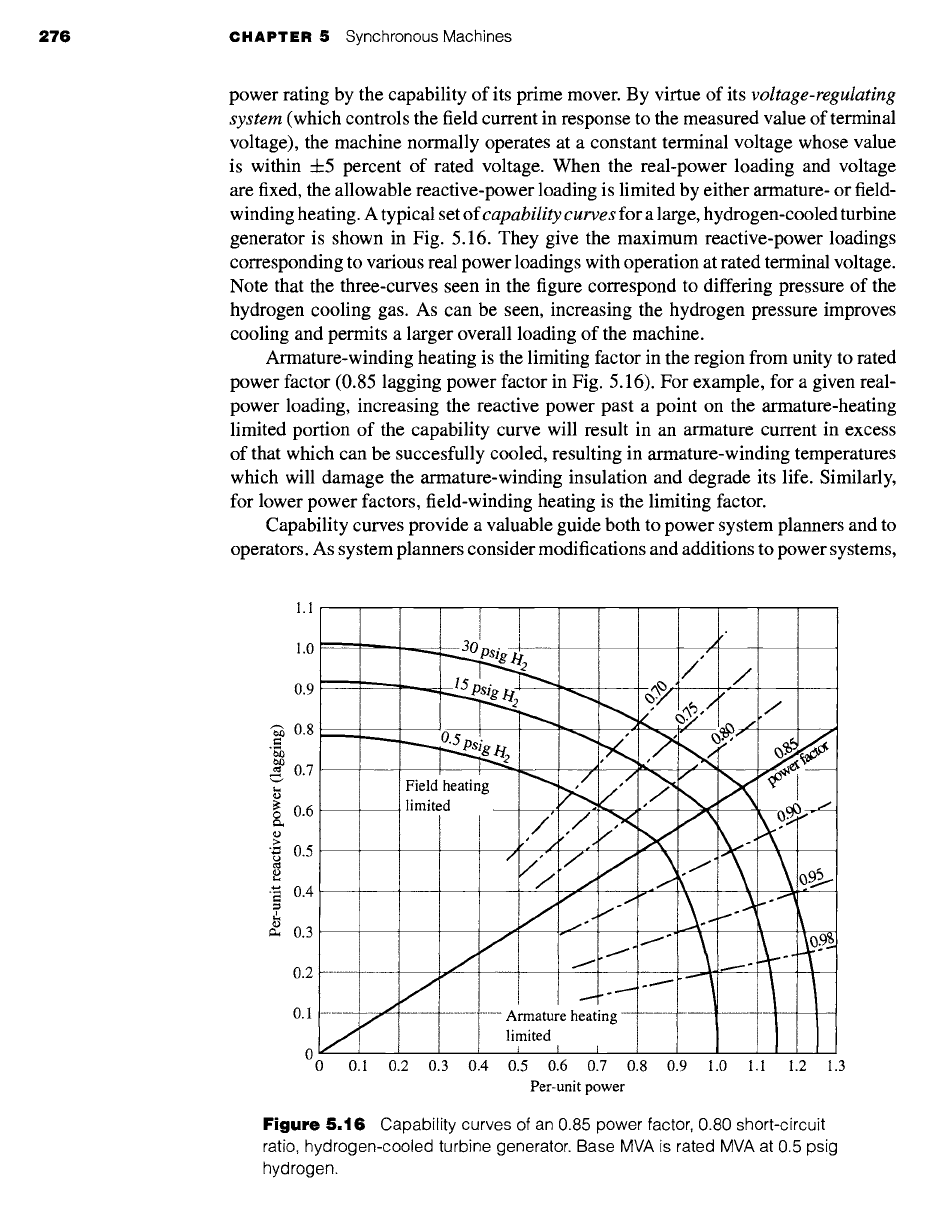
276 CHAPTER 5 Synchronous Machines
power rating by the capability of its prime mover. By virtue of its
voltage-regulating
system
(which controls the field current in response to the measured value of terminal
voltage), the machine normally operates at a constant terminal voltage whose value
is within 4-5 percent of rated voltage. When the real-power loading and voltage
are fixed, the allowable reactive-power loading is limited by either armature- or field-
winding heating. A typical set of
capability curves
for a large, hydrogen-cooled turbine
generator is shown in Fig. 5.16. They give the maximum reactive-power loadings
corresponding to various real power loadings with operation at rated terminal voltage.
Note that the three-curves seen in the figure correspond to differing pressure of the
hydrogen cooling gas. As can be seen, increasing the hydrogen pressure improves
cooling and permits a larger overall loading of the machine.
Armature-winding heating is the limiting factor in the region from unity to rated
power factor (0.85 lagging power factor in Fig. 5.16). For example, for a given real-
power loading, increasing the reactive power past a point on the armature-heating
limited portion of the capability curve will result in an armature current in excess
of that which can be succesfully cooled, resulting in armature-winding temperatures
which will damage the armature-winding insulation and degrade its life. Similarly,
for lower power factors, field-winding heating is the limiting factor.
Capability curves provide a valuable guide both to power system planners and to
operators. As system planners consider modifications and additions to power systems,
1.1
1.0
0.9
"~ 0.8
0.7
03
0.6
o
03
;>
"= 0.5
o
• ~ 0.4
03
0.3
0.2
o,
0
o o.1 o.2
,/p.
.......... 3(; j
~~P~ ~,
ps • _ [ ....
Armature heating ...............
limited
1 I I
0.3 0.4 0.5 0.6 0.7 0.8 0.9 1.0 1.1 1.2 1.3
Per-unit power
Figure
5.16 Capability curves of an 0.85 power factor, 0.80 short-circuit
ratio, hydrogen-cooled turbine generator. Base MVA is rated MVA at 0.5 psig
hydrogen.
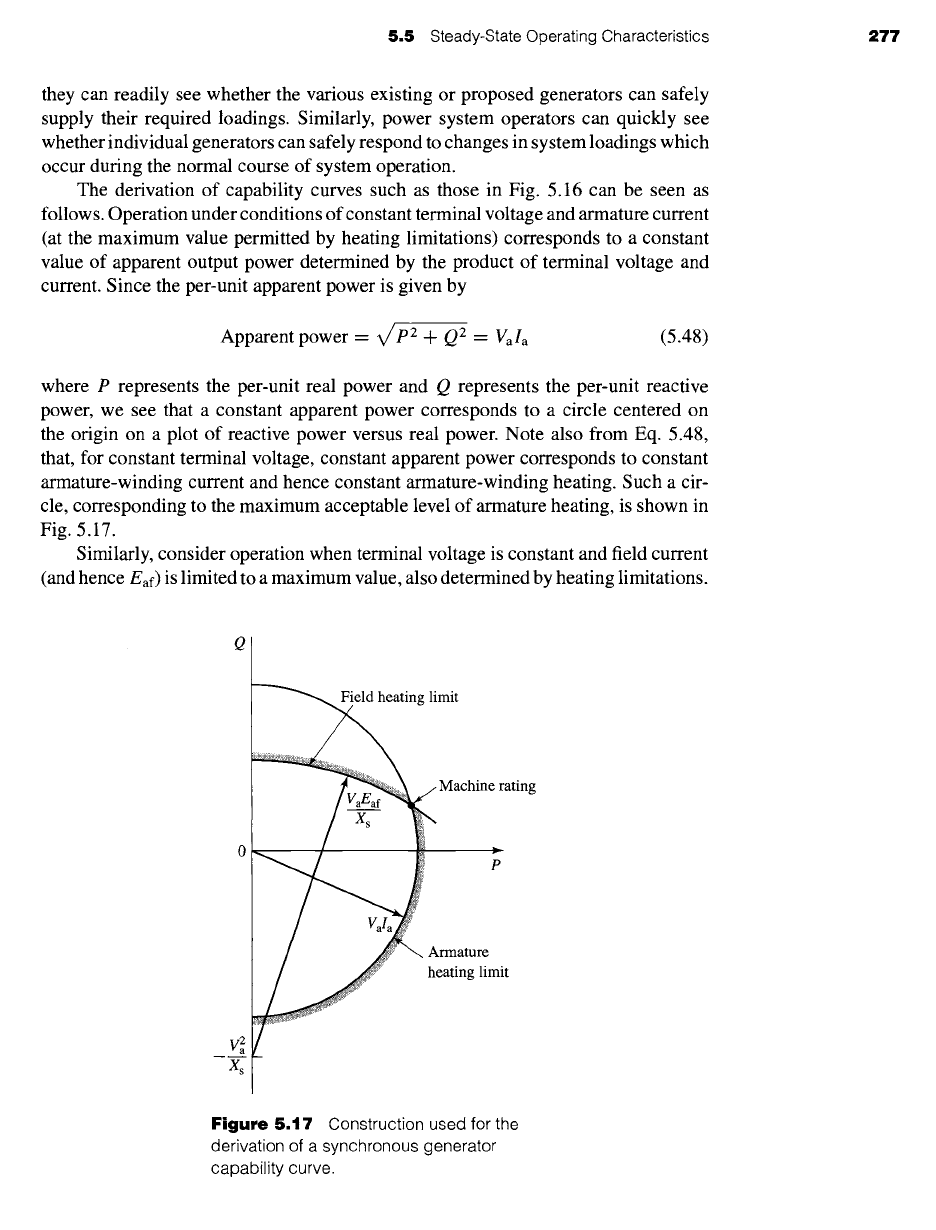
5.5 Steady-State Operating Characteristics 277
they can readily see whether the various existing or proposed generators can safely
supply their required loadings. Similarly, power system operators can quickly see
whether individual generators can safely respond to changes in system loadings which
occur during the normal course of system operation.
The derivation of capability curves such as those in Fig. 5.16 can be seen as
follows. Operation under conditions of constant terminal voltage and armature current
(at the maximum value permitted by heating limitations) corresponds to a constant
value of apparent output power determined by the product of terminal voltage and
current. Since the per-unit apparent power is given by
Apparent power- dP 2 + Q2 _ Va/a
(5.48)
where P represents the per-unit real power and Q represents the per-unit reactive
power, we see that a constant apparent power corresponds to a circle centered on
the origin on a plot of reactive power versus real power. Note also from Eq. 5.48,
that, for constant terminal voltage, constant apparent power corresponds to constant
armature-winding current and hence constant armature-winding heating. Such a cir-
cle, corresponding to the maximum acceptable level of armature heating, is shown in
Fig. 5.17.
Similarly, consider operation when terminal voltage is constant and field current
(and hence Eaf) is limited to a maximum value, also determined by heating limitations.
ng limit
] /~ Machine rating ~i ._
0
ii
rmature
ating limit
Va
Figure
5.17 Construction used for the
derivation of a synchronous generator
capability curve.
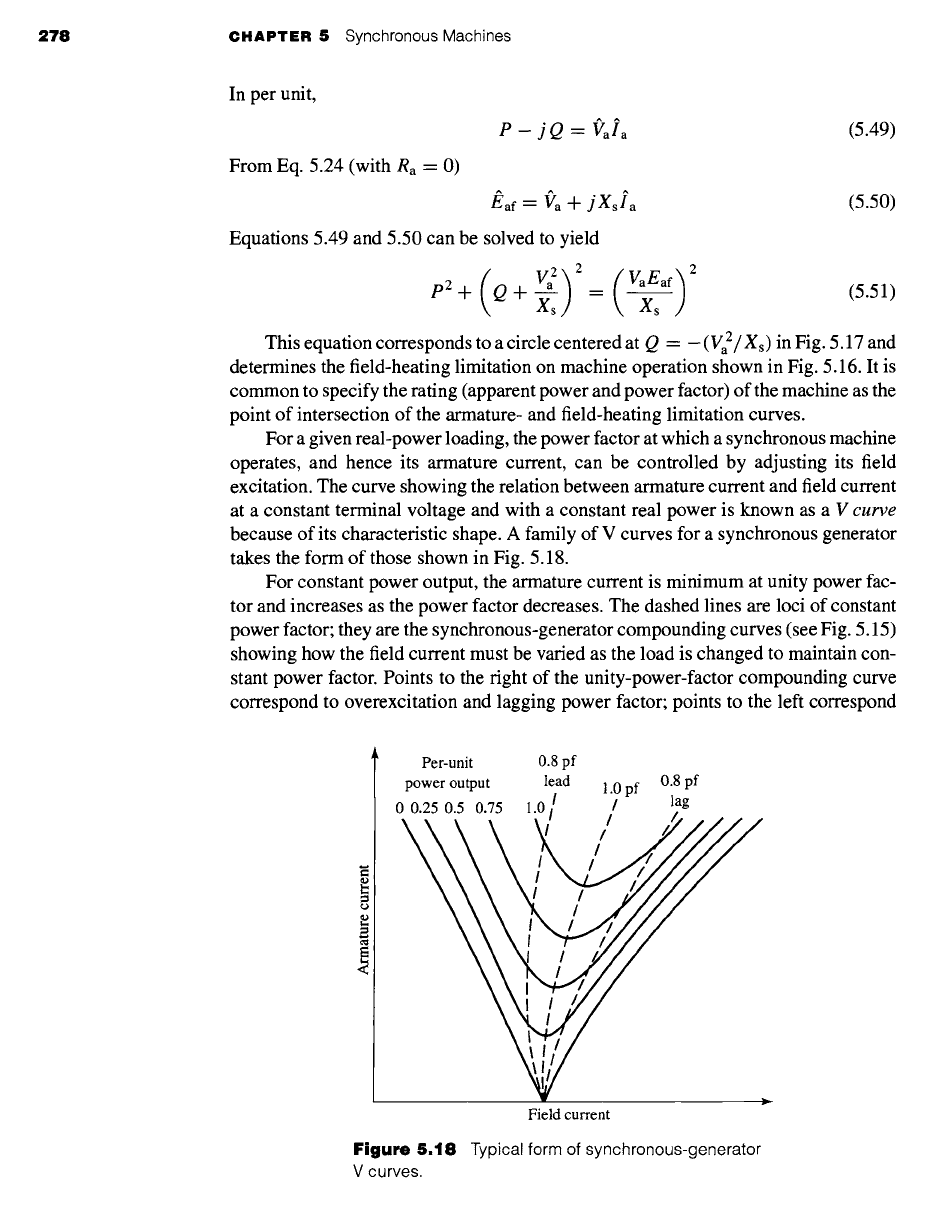
278 CHAPTER 5 Synchronous Machines
In per unit,
P - j Q = I3"aia (5.49)
From Eq. 5.24 (with Ra = 0)
/~af-"
Va
"+"
j Xs]a
(5.50)
Equations 5.49 and 5.50 can be solved to yield
( V2)2( VaEaf~2xs/I
pC+
a + -~-s
= (5.51)
This equation corresponds to a circle centered at Q =
-(V2/Xs)
in Fig. 5.17 and
determines the field-heating limitation on machine operation shown in Fig. 5.16. It is
common to specify the rating (apparent power and power factor) of the machine as the
point of intersection of the armature- and field-heating limitation curves.
For a given real-power loading, the power factor at which a synchronous machine
operates, and hence its armature current, can be controlled by adjusting its field
excitation. The curve showing the relation between armature current and field current
at a constant terminal voltage and with a constant real power is known as
a V curve
because of its characteristic shape. A family of V curves for a synchronous generator
takes the form of those shown in Fig. 5.18.
For constant power output, the armature current is minimum at unity power fac-
tor and increases as the power factor decreases. The dashed lines are loci of constant
power factor; they are the synchronous-generator compounding curves (see Fig. 5.15)
showing how the field current must be varied as the load is changed to maintain con-
stant power factor. Points to the right of the unity-power-factor compounding curve
correspond to overexcitation and lagging power factor; points to the left correspond
Per-unit 0.8 pf
power output lead 1.0 pf 0.8 pf
0 0.25 0.5 0.75 ~.0/ / lag
i l//
Field current
Figure
5.18 Typical form of synchronous-generator
V curves.
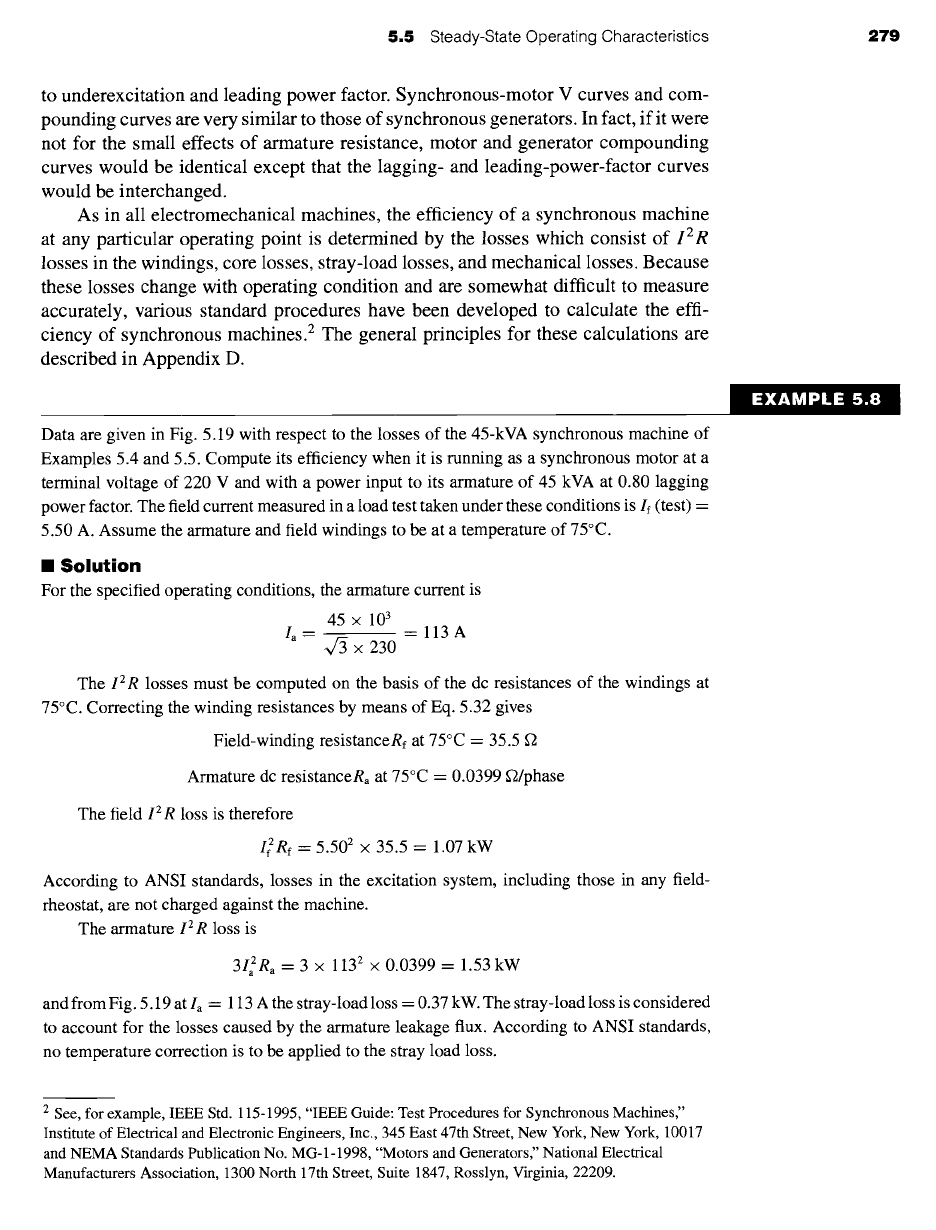
5.5 Steady-State Operating Characteristics 279
to underexcitation and leading power factor. Synchronous-motor V curves and com-
pounding curves are very similar to those of synchronous generators. In fact, if it were
not for the small effects of armature resistance, motor and generator compounding
curves would be identical except that the lagging- and leading-power-factor curves
would be interchanged.
As in all electromechanical machines, the efficiency of a synchronous machine
at any particular operating point is determined by the losses which consist of
I2R
losses in the windings, core losses, stray-load losses, and mechanical losses. Because
these losses change with operating condition and are somewhat difficult to measure
accurately, various standard procedures have been developed to calculate the effi-
ciency of synchronous machines. 2 The general principles for these calculations are
described in Appendix D.
Data are given in Fig. 5.19 with respect to the losses of the 45-kVA synchronous machine of
Examples 5.4 and 5.5. Compute its efficiency when it is running as a synchronous motor at a
terminal voltage of 220 V and with a power input to its armature of 45 kVA at 0.80 lagging
power factor. The field current measured in a load test taken under these conditions is If (test) =
5.50 A. Assume the armature and field windings to be at a temperature of 75°C.
II Solution
For the specified operating conditions, the armature current is
45 × 103
Ia = = l13A
~/3 × 230
The
IZR
losses must be computed on the basis of the dc resistances of the windings at
75°C. Correcting the winding resistances by means of Eq. 5.32 gives
Field-winding resistanceRf at 75°C = 35.5 f2
Armature dc resistanceRa at 75°C -- 0.0399 ~/phase
The field
IZR
loss is therefore
I 2Rf -- 5.502 × 35.5 -- 1.07 kW
According to ANSI standards, losses in the excitation system, including those in any field-
rheostat, are not charged against the machine.
The armature
IZR
loss is
312Ra
-- 3 × 1132 × 0.0399 = 1.53 kW
and from Fig. 5.19 at la -- 113 A the stray-load loss = 0.37 kW. The stray-load loss is considered
to account for the losses caused by the armature leakage flux. According to ANSI standards,
no temperature correction is to be applied to the stray load loss.
EXAMPLE 5.8
2 See, for example, IEEE Std. 115-1995, "IEEE Guide: Test Procedures for Synchronous Machines"
Institute of Electrical and Electronic Engineers, Inc., 345 East 47th Street, New York, New York, 10017
and NEMA Standards Publication No. MG-1-1998, "Motors and Generators," National Electrical
Manufacturers Association, 1300 North 17th Street, Suite 1847, Rosslyn, Virginia, 22209.
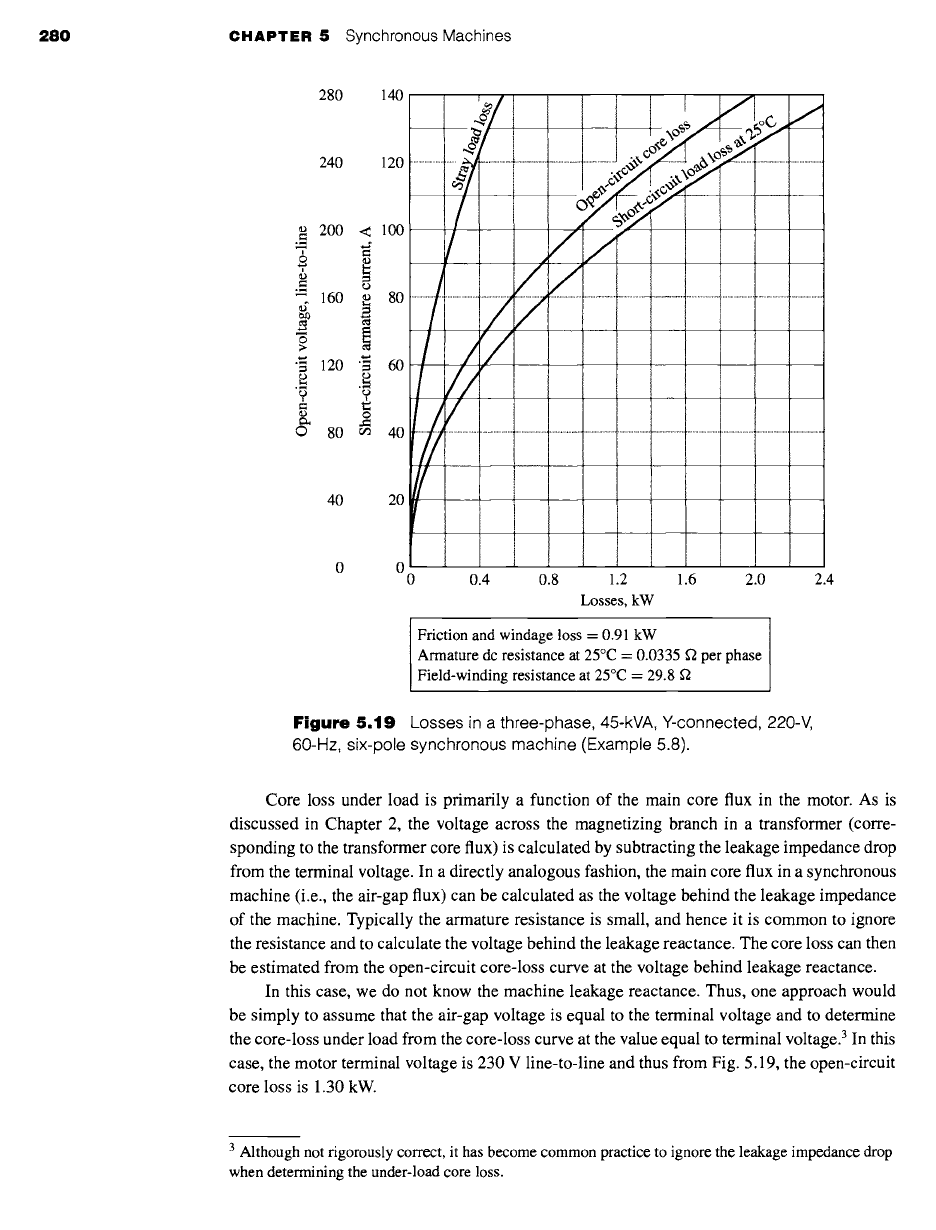
280 CHAPTER 5 Synchronous Machines
280 140
240 120
200 < 100
6 =
Z ~
d 160 ~ 80
o
• ~ 120 "~ 60
©
....... ~,,~,
~
..............
/
....... /'/ ....
~ II/',
80 ~ 40 i
.................... i .......
I/ ......... i'
4o , i . •
o o i
0 0.4 0.8 1.2 1.6 2.0 2.4
Losses, kW
Friction and windage loss = 0.91 kW
Armature dc resistance at 25°C = 0.0335 ~ per phase
Field-winding resistance at 25°C = 29.8
Figure
5.19 Losses in a three-phase, 45-kVA, Y-connected, 220-V,
60-Hz, six-pole synchronous machine (Example 5.8).
Core loss under load is primarily a function of the main core flux in the motor. As is
discussed in Chapter 2, the voltage across the magnetizing branch in a transformer (corre-
sponding to the transformer core flux) is calculated by subtracting the leakage impedance drop
from the terminal voltage. In a directly analogous fashion, the main core flux in a synchronous
machine (i.e., the air-gap flux) can be calculated as the voltage behind the leakage impedance
of the machine. Typically the armature resistance is small, and hence it is common to ignore
the resistance and to calculate the voltage behind the leakage reactance. The core loss can then
be estimated from the open-circuit core-loss curve at the voltage behind leakage reactance.
In this case, we do not know the machine leakage reactance. Thus, one approach would
be simply to assume that the air-gap voltage is equal to the terminal voltage and to determine
the core-loss under load from the core-loss curve at the value equal to terminal voltage. 3 In this
case, the motor terminal voltage is 230 V line-to-line and thus from Fig. 5.19, the open-circuit
core loss is 1.30 kW.
3 Although not rigorously correct, it has become common practice to ignore the leakage impedance drop
when determining the under-load core loss.
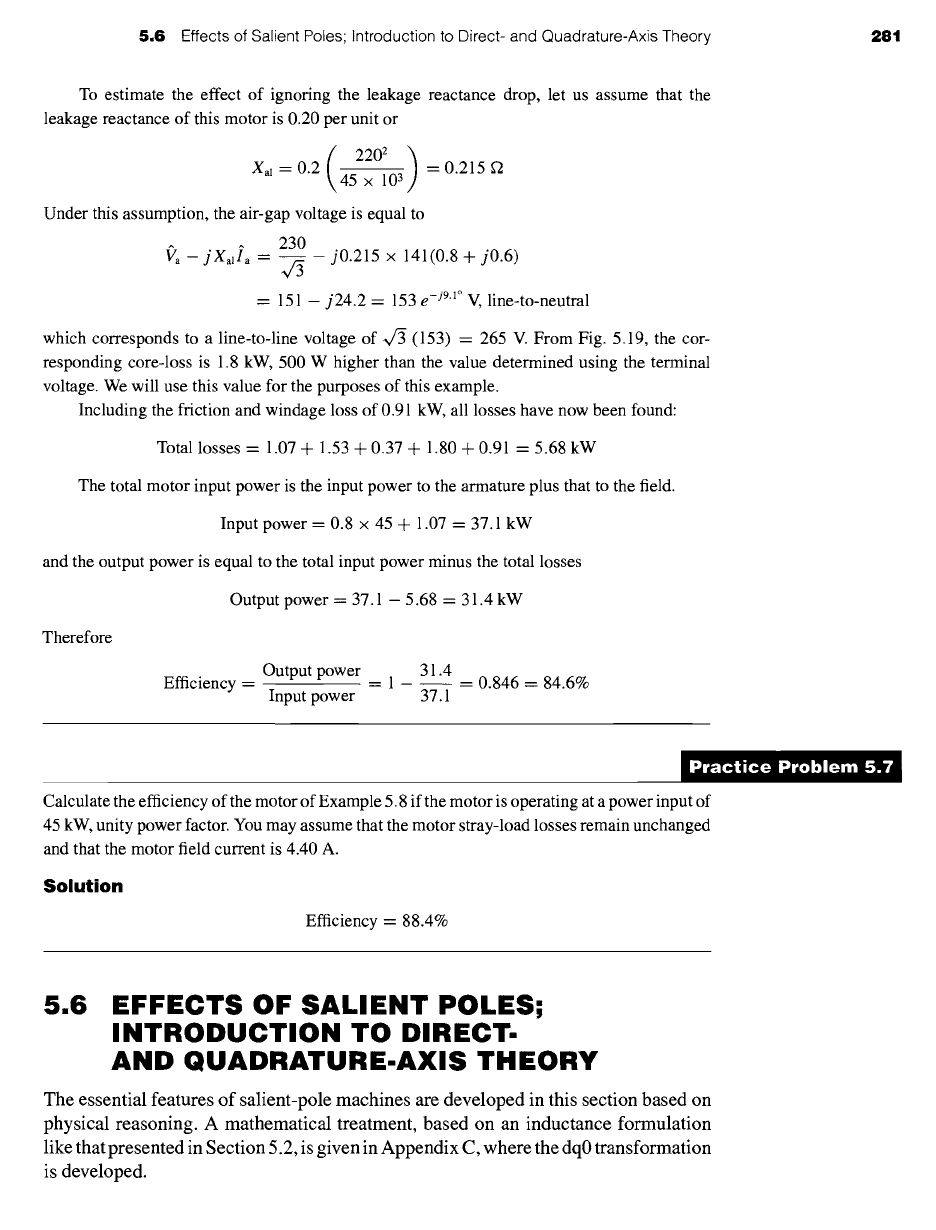
5.6 Effects of Salient Poles; Introduction to Direct- and Quadrature-Axis Theory
281
To estimate the effect of ignoring the leakage reactance drop, let us assume that the
leakage reactance of this motor is 0.20 per unit or
Xal =
0.2 45 X 103 = 0.215 ~2
Under this assumption, the air-gap voltage is equal to
~'a - jXa, la
= ~230 __ j0.215 X 141(0.8 + j0.6)
,/5
= 151 - j24.2 = 153 e -jg"l° V, line-to-neutral
which corresponds to a line-to-line voltage of ~ (153) = 265 V. From Fig. 5.19, the cor-
responding core-loss is 1.8 kW, 500 W higher than the value determined using the terminal
voltage. We will use this value for the purposes of this example.
Including the friction and windage loss of 0.91 kW, all losses have now been found:
Total losses = 1.07 + 1.53 + 0.37 + 1.80 + 0.91 = 5.68 kW
The total motor input power is the input power to the armature plus that to the field.
Input power = 0.8 x 45 + 1.07 = 37.1 kW
and the output power is equal to the total input power minus the total losses
Output power = 37.1 - 5.68 = 31.4 kW
Therefore
Output power 31.4
Efficiency = = 1 = 0.846 = 84.6%
Input power 37.1
Calculate the efficiency of the motor of Example 5.8 if the motor is operating at a power input of
45 kW, unity power factor. You may assume that the motor stray-load losses remain unchanged
and that the motor field current is 4.40 A.
Solution
Efficiency = 88.4%
5.6
EFFECTS OF SALIENT POLES;
INTRODUCTION TO DIRECT-
AND QUADRATURE-AXIS THEORY
The essential features of salient-pole machines are developed in this section based on
physical reasoning. A mathematical treatment, based on an inductance formulation
like that presented in Section 5.2, is given in Appendix C, where the dq0 transformation
is developed.
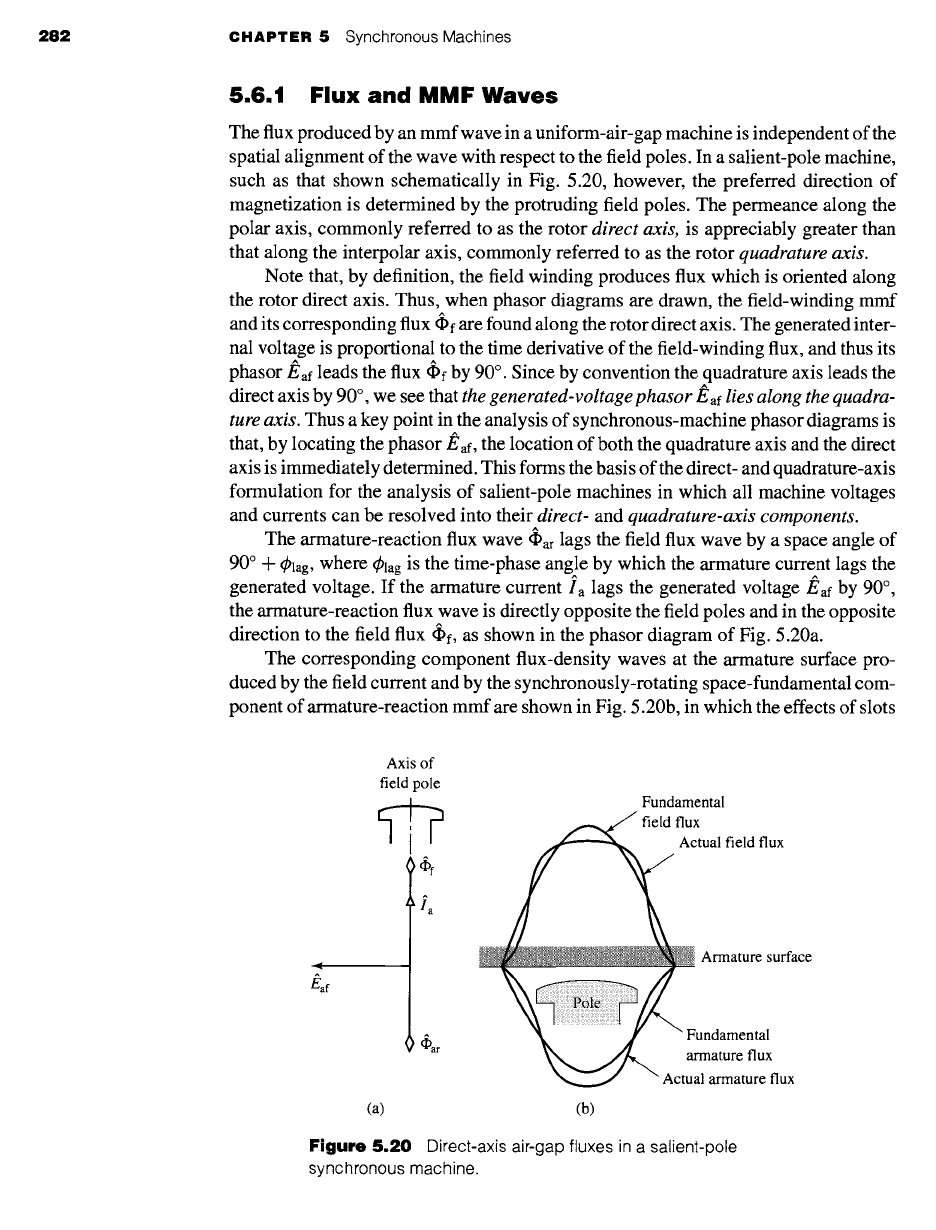
282 CHAPTER 5 Synchronous Machines
5.6.1 Flux and MMF Waves
The flux produced by an mmf wave in a uniform-air-gap machine is independent of the
spatial alignment of the wave with respect to the field poles. In a salient-pole machine,
such as that shown schematically in Fig. 5.20, however, the preferred direction of
magnetization is determined by the protruding field poles. The permeance along the
polar axis, commonly referred to as the rotor direct axis, is appreciably greater than
that along the interpolar axis, commonly referred to as the rotor quadrature axis.
Note that, by definition, the field winding produces flux which is oriented along
the rotor direct axis. Thus, when phasor diagrams are drawn, the field-winding mmf
and its corresponding flux
(~)f are
found along the rotor direct axis. The generated inter-
nal voltage is proportional to the time derivative of the field-winding flux, and thus its
phasor
Eaf leads
the flux
(~)f
by 90 °. Since by convention the quadrature axis leads the
direct axis by 90 °, we see that the generated-voltage phasor
Eaf
lies
along the quadra-
ture axis. Thus a key point in the analysis of synchronous-machine phasor diagrams is
that, by locating the phasor
J~af, the
location of both the quadrature axis and the direct
axis is immediately determined. This forms the basis of the direct- and quadrature-axis
formulation for the analysis of salient-pole machines in which all machine voltages
and currents can be resolved into their direct- and quadrature-axis components.
The armature-reaction flux wave 4)ar lags the field flux wave by a space angle of
90 ° + (Plag, where (~lag is the time-phase angle by which the armature current lags the
generated voltage. If the armature current Ia lags the generated voltage
Eaf
by 90 °,
the armature-reaction flux wave is directly opposite the field poles and in the opposite
direction to the field flux 4)f, as shown in the phasor diagram of Fig. 5.20a.
The corresponding component flux-density waves at the armature surface pro-
duced by the field current and by the synchronously-rotating space-fundamental com-
ponent of armature-reaction mmf are shown in Fig. 5.20b, in which the effects of slots
Axis of
field pole
(a) (b)
Fundamental
:tual field flux
Armature surface
Undamental
rmature flux
al armature flux
Figure 5.20 Direct-axis air-gap fluxes in a salient-pole
synchronous machine.
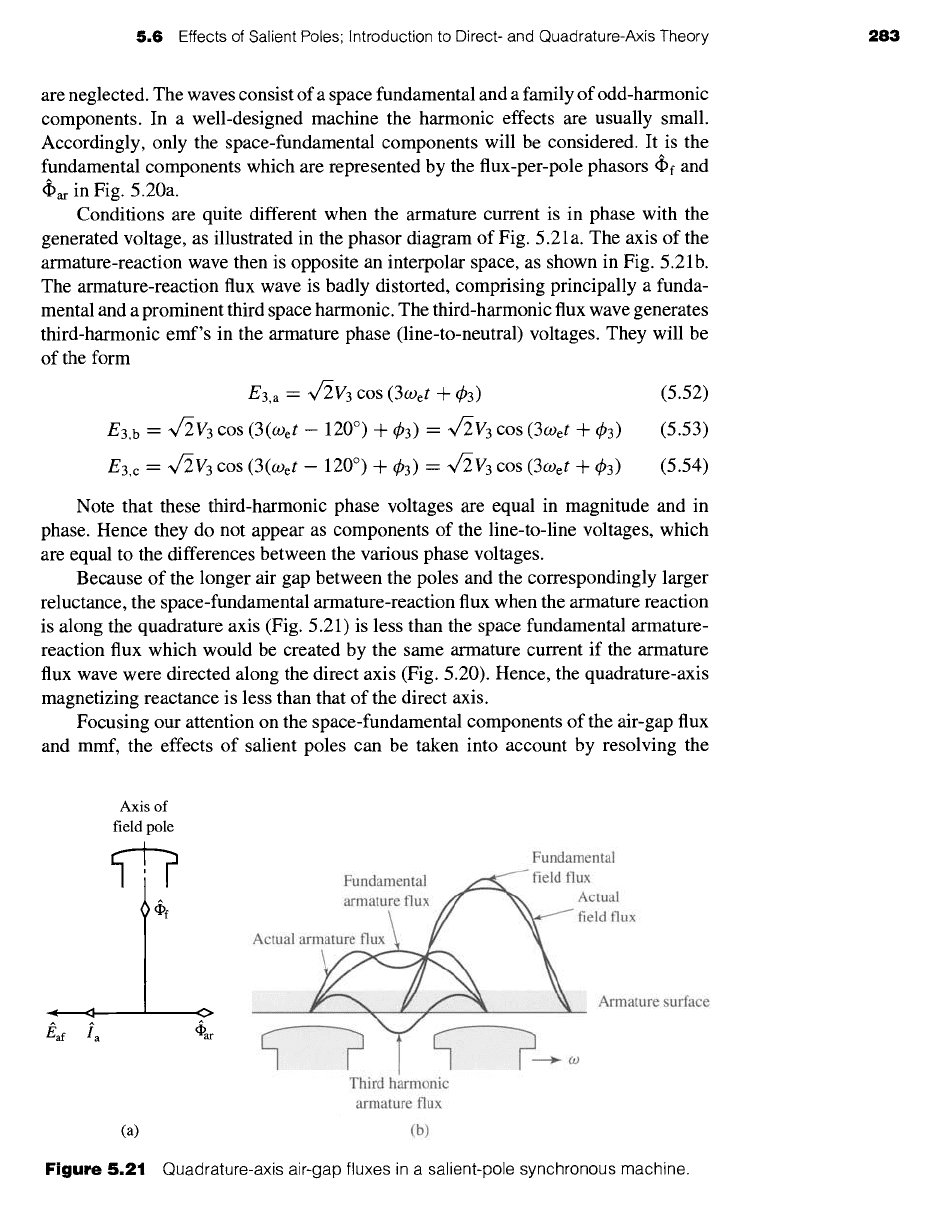
5,6 Effects of Salient Poles; Introduction to Direct- and Quadrature-Axis Theory
283
are neglected. The waves consist of a space fundamental and a family of odd-harmonic
components. In a well-designed machine the harmonic effects are usually small.
Accordingly, only the space-fundamental components will be considered. It is the
fundamental components which are represented by the flux-per-pole phasors
(I)f and
~a~ in Fig. 5.20a.
Conditions are quite different when the armature current is in phase with the
generated voltage, as illustrated in the phasor diagram of Fig. 5.21 a. The axis of the
armature-reaction wave then is opposite an interpolar space, as shown in Fig. 5.21 b.
The armature-reaction flux wave is badly distorted, comprising principally a funda-
mental and a prominent third space harmonic. The third-harmonic flux wave generates
third-harmonic emf's in the armature phase (line-to-neutral) voltages. They will be
of the form
E3,a = x/~V3 cos (3COet + ¢3) (5.52)
E3,b -= V/2V3 cos (3(COet -- 120 °) + ¢3) = V~V3 cos (3Oget q- ¢3) (5.53)
E3,c -- ~/-2V3 cos (3(COet - 120 °) + ¢3) -- ~/2V3 cos (3Oget q- ¢3) (5.54)
Note that these third-harmonic phase voltages are equal in magnitude and in
phase. Hence they do not appear as components of the line-to-line voltages, which
are equal to the differences between the various phase voltages.
Because of the longer air gap between the poles and the correspondingly larger
reluctance, the space-fundamental armature-reaction flux when the armature reaction
is along the quadrature axis (Fig. 5.21) is less than the space fundamental armature-
reaction flux which would be created by the same armature current if the armature
flux wave were directed along the direct axis (Fig. 5.20). Hence, the quadrature-axis
magnetizing reactance is less than that of the direct axis.
Focusing our attention on the space-fundamental components of the air-gap flux
and mmf, the effects of salient poles can be taken into account by resolving the
&f Ia t~ar
(a)
Third harmonic
armature flux
(b)
Axis of
field pole
Fundamental
ctual
eld flux
Armature surface
Figure
5.21 Quadrature-axis air-gap fluxes in a salient-pole synchronous machine.

284 CHAPTER 5 Synchronous Machines
I I
I I
I I
I I
ia
+R
I
~af
,v
Quadrature
axis
Direct axis
Figure
5.22 Phasor diagram of a salient-pole
synchronous generator.
armature
current
[a into two components, one along the direct axis and the other along
the quadrature axis as shown in the phasor diagram of Fig. 5.22. This diagram is drawn
for a unsaturated salient-pole generator operating at a lagging power factor. The direct-
axis component id of the armature current, in time-quadrature with the generated
voltage
J~af,
produces a component of the space-fundamental armature-reaction flux
t~)ad along the axis of the field poles (the direct axis), as in Fig. 5.20. The quadrature-
axis component iq, in phase with the generated voltage, produces a component of
the space-fundamental armature-reaction
flux
t~aq in space-quadrature with the field
poles, as in Fig. 5.21. Note that the subscripts d ("direct") and q ("quadrature") on
the armature-reaction fluxes refer to their space phase and not to the time phase of
the component currents producing them.
Thus a direct-axis quantity is one whose magnetic effect is aligned with the axes
of the field poles; direct-axis mmf's produce flux along these axes. A quadrature-axis
quantity is one whose magnetic effect is centered on the interpolar space. For an
unsaturated machine, the armature-reaction flux
t~ar is
the sum of the components
t~ad and
t~)aq. The resultant flux
t~ R
is the sum of ~ar and the field flux
t~f.
5.6.2 Phasor Diagrams for Salient.Pole Machines
With each of the component
currents Id
and /~q there is associated a component
synchronous-reactance voltage drop, j idXd and j iqXq respectively. The reactances
Xd and Xq are, respectively, the direct- and quadrature-axis synchronous reactances;
they account for the inductive effects of all the space-fundamental fluxes created by
the armature currents along the direct and quadrature axes, including both armature-
leakage and armature-reaction fluxes. Thus, the inductive effects of the direct- and
quadrature-axis armature-reaction flux waves can be accounted for by direct- and
quadrature-axis magnetizing reactances, X¢d and X~0q respectively, similar to the
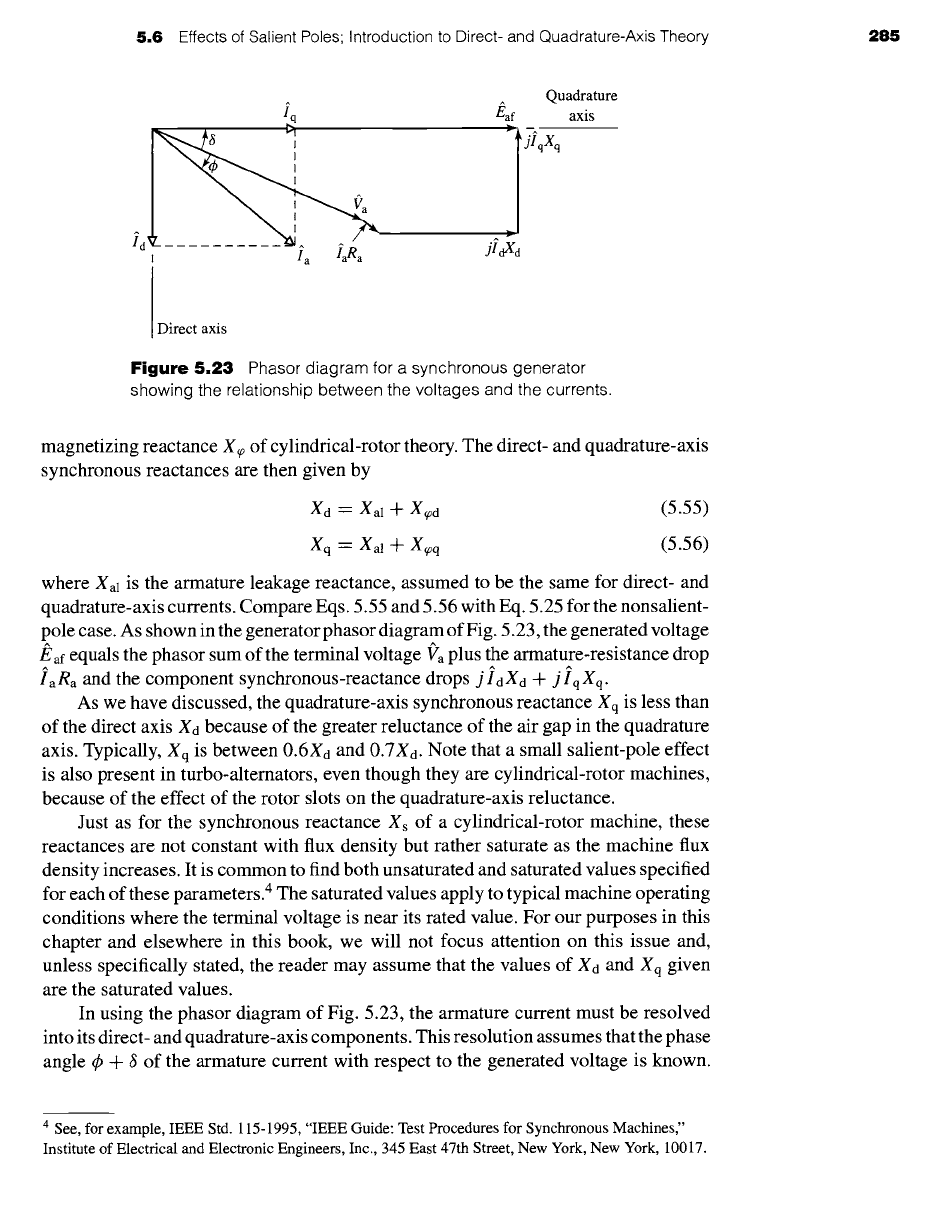
5.6
Effects of Salient Poles; Introduction to Direct- and Quadrature-Axis Theory 285
~1 d
I a IaRa
Quadrature
/~af axis
jIqXq
v
g~Xd
Direct axis
Figure
5.23 Phasor diagram for a synchronous generator
showing the relationship between the voltages and the currents.
magnetizing reactance X~0 of cylindrical-rotor theory. The direct- and quadrature-axis
synchronous reactances are then given by
X d -- Xal -~- X~o d (5.55)
Xq -- Xal-'[- X~pq
(5.56)
where Xa] is the armature leakage reactance, assumed to be the same for direct- and
quadrature-axis currents. Compare Eqs. 5.55 and 5.56 with Eq. 5.25 for the nonsalient-
pole case. As shown in the generator phasor diagram of Fig. 5.23, the generated voltage
/~af equals the phasor sum of the terminal voltage f'a plus the armature-resistance drop
Iaga and the component synchronous-reactance drops j
IdXd "-[-
j IqXq.
As we have discussed, the quadrature-axis synchronous reactance Xq is less than
of the direct axis Xd because of the greater reluctance of the air gap in the quadrature
axis. Typically, Xq is between
0.6Xa
and 0.7Xd. Note that a small salient-pole effect
is also present in turbo-altemators, even though they are cylindrical-rotor machines,
because of the effect of the rotor slots on the quadrature-axis reluctance.
Just as for the synchronous reactance Xs of a cylindrical-rotor machine, these
reactances are not constant with flux density but rather saturate as the machine flux
density increases. It is common to find both unsaturated and saturated values specified
for each of these parameters. 4 The saturated values apply to typical machine operating
conditions where the terminal voltage is near its rated value. For our purposes in this
chapter and elsewhere in this book, we will not focus attention on this issue and,
unless specifically stated, the reader may assume that the values of Xd and Xq given
are the saturated values.
In using the phasor diagram of Fig. 5.23, the armature current must be resolved
into its direct- and quadrature-axis components. This resolution assumes that the phase
angle 4~ + 3 of the armature current with respect to the generated voltage is known.
4 See, for example, IEEE Std. 115-1995, "IEEE Guide: Test Procedures for Synchronous Machines,"
Institute of Electrical and Electronic Engineers, Inc., 345 East 47th Street, New York, New York, 10017.
